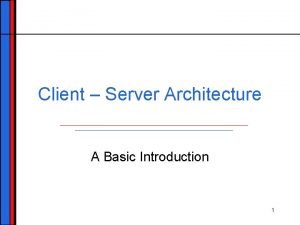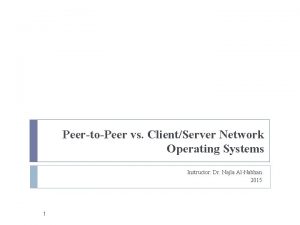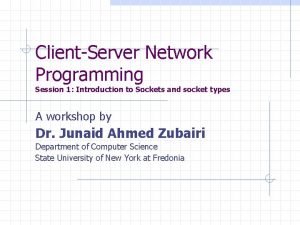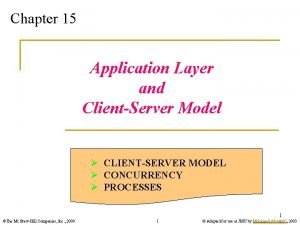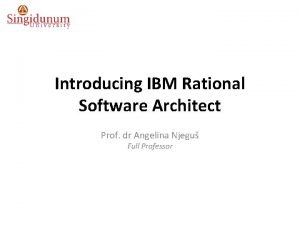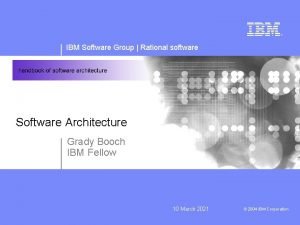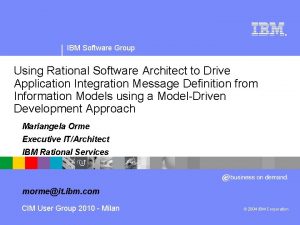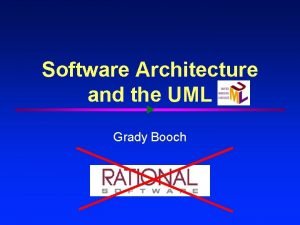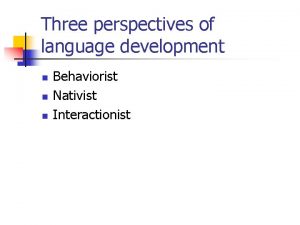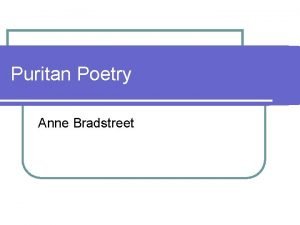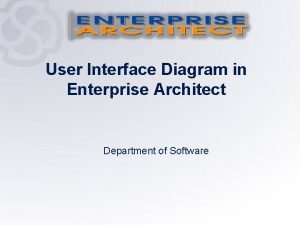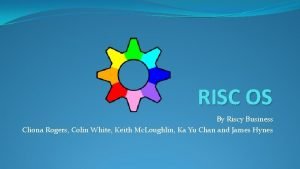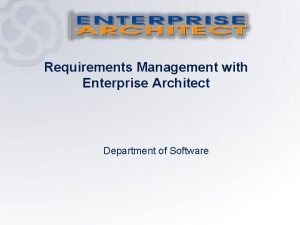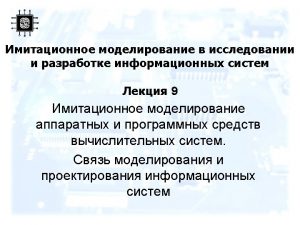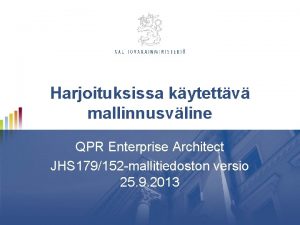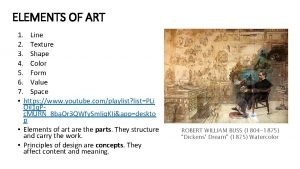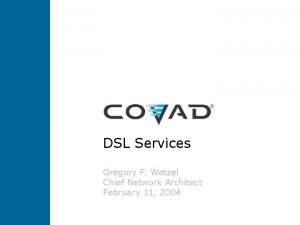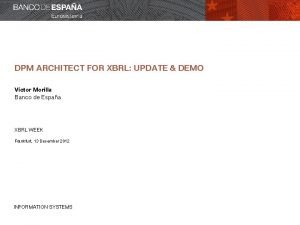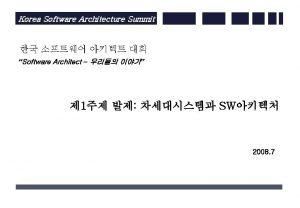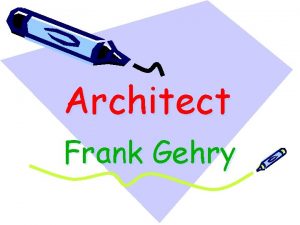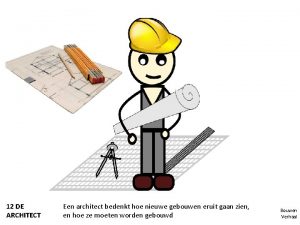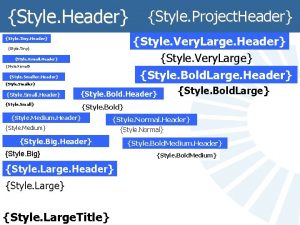SOFTWARE ARCHITECT STYLE Lecture 4 CLIENTSERVER ClientServer The

































- Slides: 33

SOFTWARE ARCHITECT STYLE Lecture 4

CLIENT-SERVER

Client-Server The calculation model has undergone the following six generations: § 1965 -1985: Centralized processing mode with mainframes as the core § 1986 -1990: The file-sharing computing mode centered on PC/file server § 1990 -1996: Distributed computing mode based on C/S structure § 1996 -: Web-centric, B / S structure as the mainstream of distributed computing mode § 2000 -: Pervasive computing mode with various types of mobile devices at its core; § 2005 -: Grid, P 2 P, web 2. 0 as the core of the distributed computing mode

Client-Server Architecture § An application system is divided into two logically separate parts, each part plays different roles to complete different functions of multiple computers together to complete a unified task § Client(front-end) § business logic, interface to server communications § Server(back-end) § interface to client communication, business logic, data management § Generally speaking: § The client makes a request to the server for a specific job § The server processes the client's request and returns the result

Client-Server C / S structure development process: § 2 -tier C/S § 3 -tier C/S § multi-tier C/S Customer interface Database server Customer interface Business Logic Server Database server

Client-Server 2 -tier C/S

Client-Server 2 -tier C/S § Components: § Database Server: the database that stores data, the business logic responsible for data processing § Client application: § GUI: User Interface § Business logic: Use the application on the client to process the data § Connector: Call-Return mechanism via network or implicit invocation mechanism § Client Server: The client sends the request to the server and accepts the result

Client-Server The division of business logic: more in the client or server more? § Fat client: Clients execute most of the data processing operations. § Thin client: Clients have little or no business logic Fat client Thin client Less network bandwidth Lower IT admin cost Fewer server requirements Easier to secure Better computing performance Worthless to thieves

Client-Server 2 -tier C/S application § The 2 -tier C/S architecture is often used for non-real-time information processing systems that management and operation is less complex. § Suitable for lightweight transactions. § When the business logic changes less and the number of users is less than 100, the two-layer C / s structure performs well.

Client-Server 3 -tier C/S § A middle tier is added between the client and the database server § The middle tier can be: Transaction monitoring server, Message Server,Application server. § The middle layer responsible for message queuing, business logic implementation, data transmission and other functions.

Client-Server 3 -tier C/S § Presentation layer: § User interface part, responsible for the dialogue between users and applications; § Check user input. Display the output of the application § Usually use the GUI § In the change, only need to rewrite the display control and data checking procedures, without affecting the other layers § Does not contain or contain part of the business logic.

Client-Server 3 -tier C/S § Functional layer: § The main body of the application, including most of the business processing logic (usually in the form of business components, such as Java. Bean/EJB/COM). § Obtain user input data from presentation layer and process it. § The process needs to retrieve data from the data layer or update data to the data layer § The processing result is returned to the presentation layer

Client-Server 3 -tier C/S § Data layer: § DMBS § Accept the data query request from the function layer, execute the request, and return the query result to the function layer § Accept the data store request from the functional layer and write the data to the database § The results of the request should also be returned to the functional layer

Client-Server 3 -tier C/S physical structure § 2 -tier C/S has separated the data layer § 3 -tier C/S will have to separate the presentation layer and the functional layer to form a separate program, and to make the interface between the two concise and clear. § Question: How does these three levels physically distribute? Server 1 Server 2 Data Layer Functional Layer Client Presentation Layer a)Place the data layer and the functionality layer on the same server. Presentation Layer b)Place the data layer and the functionality layer on the different server. Data Layer Functional Layer Presentation Layer c)Place the functionality layer on client

Client-Server 3 -tier C/S physical structure based on Cluster § In fact, the functional layer does not usually reside on the same server, nor does the data layer. § If the functional layer (data layer) distributed in multiple servers, then a cluster-based C/S physical distribution mode is formed

Client-Server 3 -tier C/S structure –Advantage § Good flexibility and scalability. When a layer changes, it does not affect the change of other layers. For situations where the environment and application conditions are frequently changing, the purpose can be achieved as long as the application layer's implementation changes accordingly. § Develop language independence. For example, the client can be developed by C ++ and the middle layer can be developed by Java. § With shareability. A single application server can serve client applications on different platforms, greatly saving development time and capital investment. § Has good security. In this architecture, the client application can not directly access the data. The application server can not only control which data is changed and accessed, but also control the way of data changing and accessment. § Enhanced reusability of business objects. An "enterprise object" is an object that encapsulates the enterprise's logic code to perform a specific function. As component technology evolves, this reusable component paradigm becomes more accepted by software developers. § Become a true thin client, which has a high stability, scalability and execution efficiency. § Services can be managed together, serving the client in a unified manner, with good fault tolerance and load balancing capabilities.

Client-Server Difference between 3 -tier C/S and 2 -tier C/S ① In system management, the 2 -tier architecture is complicated and requires many business logic to be managed on the client side. The 3 -tier architecture is relatively simple and applications can be centrally managed using server-side system management tools. ② In terms of security, 2 -tier architecture security is relatively low, is a data-level security, 3 -tier architecture has a higher security, you can adjust services and methods on the server side. ③ In terms of data encapsulation, the interaction between the client and the server in the 2 -tier architecture uses SQL statements, the data indicates that the data is exposed; the 3 -tier structure is better, and the client invokes the service or the method to complete it. ④ In terms of reusing applications, 2 -tier architecture is not easy to reuse because it is a single client; and the 3 -tier architecture performs well in reuse, which can reuse services and objects.

Client-Server Difference between 3 -tier C/S and 2 -tier C/S ⑤ For heritage application integration, heritage application integration is difficult for a 2 -tier client-server architecture because of limited customer communication link management; and for a 3 -tier client-server architecture, it is possible to leverage packaging services and objects through the gateway, network connectors, routers for legacy application integration. ⑥ In terms of Internet support, internet support is poor due to limited network bandwidth for downloading thick clients in a 2 tier client-server architecture; and the 3 -tier client-server architecture often has only a web browser on the client side , So the performance of this area is excellent. ⑦ In multi-database support, in a 2 -tier client-server architecture, it is almost impossible to use multiple databases because the database is locked by the vendor; in a 3 -tier structure, there are several databases that one business transaction can use.

Client-Server Browser/Server Architecture § B/S is an implement of 3 -tier C/S style § Presentation layer : Browser § Logical layer: § Web server § Application server § Data layer: database server

Client-Server Browser/Server Architecture § J 2 EE platform is a typical implementation of B / S structure

Client-Server Difference between a 3 -tier layer architecture and a 3 -tier client-server software architecture: § The main difference between a 3 -tier layer architecture and a 3 -tier client-server software architecture is that the layers involved in a typical hierarchical layers architecture refer to the logical tier, whereas those involved in a 3 -tiered client-server architecture are physically considered. That is, the client runs on the PC, the service layer is deployed on the application server, and the database layer includes the database and database management system software deployed on the database server.

PEER-TO-PEER

Peer-to-Peer § Client-server architecture Disadvantages: the entire web service depends on the server, and if there is no server, there is no value in the existence of the network. § P 2 P architecture is a non-centralized architecture, that is, there is no server or client concept in the network. In the P 2 P architecture model, each node in the network is considered as a peer, they have the same status, any one node can request services and provide services, that is, each node is Client, also a Server. § The origins of P 2 P architecture date back to 1998. Shawn Fanning, an 18 -year-old college student in the US, was inspired by talking to his classmates about the often ineffective online links to MP 3 s and decided to set up his own company in order to make effective use of computers and databases distributed around the world.

Peer-to-Peer § P 2 P distributed network architecture consists of a large number of participants or peers, each node can provide other participants with services such as processing power, hard disk storage, network bandwidth, etc. Each participant interacts directly with each other without the need for an intermediary web server. Each node is the provider of resources, but also the consumers of resources. A P 2 P architecture without a central server is shown.

Peer-to-Peer § Centerless P 2 P system is called pure P 2 P architecture. In a pure P 2 P software architecture, each node is a client, and each node is also a server. When a node serves as a client, the node has a function of sending a service request command receiving a service result. When the node serves as a server, the node receives a service request command, processes the service request and executes the service, sends responses and servers results. The P 2 P architecture is a distributed application architecture that distributes tasks or workloads to peer nodes in a P 2 P network without the need for centralized server coordination. These completely equitable peer nodes are free to allocate some of their own resources, such as computing power, disk storage, or network bandwidth, for other peer nodes to use.

Peer-to-Peer Centralized P 2 P—The 1 st generation of P 2 P software architecture § The centralized directory-based P 2 P software architecture uses a central directory server to manage P 2 P nodes, and P 2 P nodes register their own information about the name, address, resources, metadata, available services to the central directory server, but all content is stored in each node rather than on the server. § When a node to find a service, the node firstly connects to the directory server, and then based on information in the directory server query and network traffic, delay and other information to select and locate other peers. Once they find the node they want to connect to, they establish a connection directly without having to go through the Central Directory Server.

Peer-to-Peer Centralized P 2 P—The 1 st generation of P 2 P software architecture § The structure of the centralized directory software architecture is shown. In this figure, each node knows the address of the directory server. The dotted line represents each node ready to connect to the directory server. The solid line represents the connection between the peers. § In the figure, except for the directory server, there is a connection between every other peer node, forming a network. Directory servers are formally “hubs” of the peer-to-peer network. However, the directory server, in fact, does not really have any other functions than providing the basic registered information for each node, so the architecture is fundamentally different from the traditional client-server architecture.

Peer-to-Peer § In the centralized directory-based P 2 P software architecture, the process of discovering services and executing services is shown in figure. § In the figure, Client A wants to find a service on the peer-to-peer network, then: ① Client A makes a request to the directory server. ② The Directory Server finds the required peer for A from the list. ③ Client A communicates directly with the new peer. This figure is from Client D to download the file to Client A. § Disadvantages: network stability is poor. Once the server fails, the peer under the server may all fail.

Peer-to-Peer Pure P 2 P—The 2 nd generation of P 2 P software architecture § Pure P 2 P architecture is also known as broadcast P 2 P model, it does not have a centralized central directory server, each user randomly access the network, and adjacent to their own set of neighbor nodes through end-to-end connections to form a logical coverage network of. Each peer can be both a client and a server, all with the same capabilities as their neighbors. Each peer node is a node in the network with no central router. § Content queries and content sharing between peers are broadcast directly through adjacent nodes, while each node can also record the search track to prevent the search loop from being generated. § Pure P 2 P network structure solves the problem of network structure centralization, and the expansibility and fault tolerance are better.

Peer-to-Peer Pure P 2 P discovery service and execution service process: ① ② ③ ④ Node P 1 first connects to the network. Node P 1 uses ping packets to broadcast messages to other nearby nodes in order to find online nodes in the network. Online nodes pong packet replies and provide the information of other online nodes, including the IP address, port number, the number of files can be shared. Send query message, an inquiry message is used to search for files shared by other nodes in the network, including the query string and the minimum required link speed. ⑤ Get query hit reply message. The P 1 inquiry reply message contains a list of all the files that match a particular inquiry, the size of each file and the speed of the reaction nodes' links. ⑥ Use push messages to upload files to the client.

Peer-to-Peer Pure P 2 P architecture has the following disadvantages: § Service discovery is limited and difficult. In a large P 2 P network, the query will encounter a small range of queries difficult. § Since none of the peer nodes knows the structure of the whole network, the search algorithm in the network is flooded. The flood of control information consumes a large amount of bandwidth and may quickly cause network congestion and even network instability, resulting in poor availability of the entire network. § The system is vulnerable to spam, even malicious attacks on the virus.

Peer-to-Peer Unstructured hierarchical Pure P 2 P—The 3 rd generation of P 2 P software architecture § The traditional pure P 2 P architecture has many problems in operation, mainly reflected in the second generation of flood-based P 2 P networks when the network becomes very large, the system search / response rate will become very low. In order to solve this problem, the third generation P 2 P system based on hierarchy came into being in 2001. By dividing the peer into two categories: super-node and leaf-node, the super-node is formed into an overlay network based on the original peer-to-peer network, and the concept of hierarchy is introduced. This improved architecture is an unstructured Hierarchical Pure P 2 P architecture with a network topology as shown.

Peer-to-Peer Unstructured hierarchical Pure P 2 P—The 3 rd generation of P 2 P software architecture § Leaf nodes are only connected to their super-nodes; super-nodes, in addition to maintaining their own leaf nodes, are connected to other super-nodes in the supernode's overlay net. Super nodes serve as proxy nodes for their own leaf nodes. The super-node is responsible for passing the query request to other super-nodes or if it knows exactly one of its leaf nodes can answer the request, it passes the request to the leaf node. The unstructured Hierarchical Pure P 2 P architecture has significantly improved the network query efficiency by introducing a super-node overlay network based on the original peer-to-peer network. The query rate of unstructured hierarchical pure P 2 P system is also much superior to the original pure P 2 P architecture.
 Introduction to client server architecture
Introduction to client server architecture System.net.peertopeer
System.net.peertopeer Clientserver network
Clientserver network Clientserver model
Clientserver model Clientserver model
Clientserver model Ibm rational software architect
Ibm rational software architect Rational software architect
Rational software architect Rational software architect
Rational software architect Rational software architect
Rational software architect Rational software architect
Rational software architect 01:640:244 lecture notes - lecture 15: plat, idah, farad
01:640:244 lecture notes - lecture 15: plat, idah, farad Modified block format parts
Modified block format parts Tone formal and informal
Tone formal and informal Formal vs informal writing
Formal vs informal writing Referential vs expressive style
Referential vs expressive style Puritan plain style poem examples
Puritan plain style poem examples Periodic style vs running style
Periodic style vs running style Requirement analysis in software engineering notes
Requirement analysis in software engineering notes Wwwwwhh
Wwwwwhh Lecture presentation software
Lecture presentation software Learning task 2 im an architect
Learning task 2 im an architect Architects act 1967
Architects act 1967 Enterprise architect deployment diagram
Enterprise architect deployment diagram Leadership architect competencies
Leadership architect competencies Sarah mocke
Sarah mocke Andrew hodgkinson architect
Andrew hodgkinson architect Requirements management enterprise architect
Requirements management enterprise architect Platform architect synopsys
Platform architect synopsys Prosessikartta malli
Prosessikartta malli The great wave off kanagawa elements of art
The great wave off kanagawa elements of art Dpm architect
Dpm architect Chief network architect
Chief network architect Xbrl demo
Xbrl demo Architect act 1967
Architect act 1967
